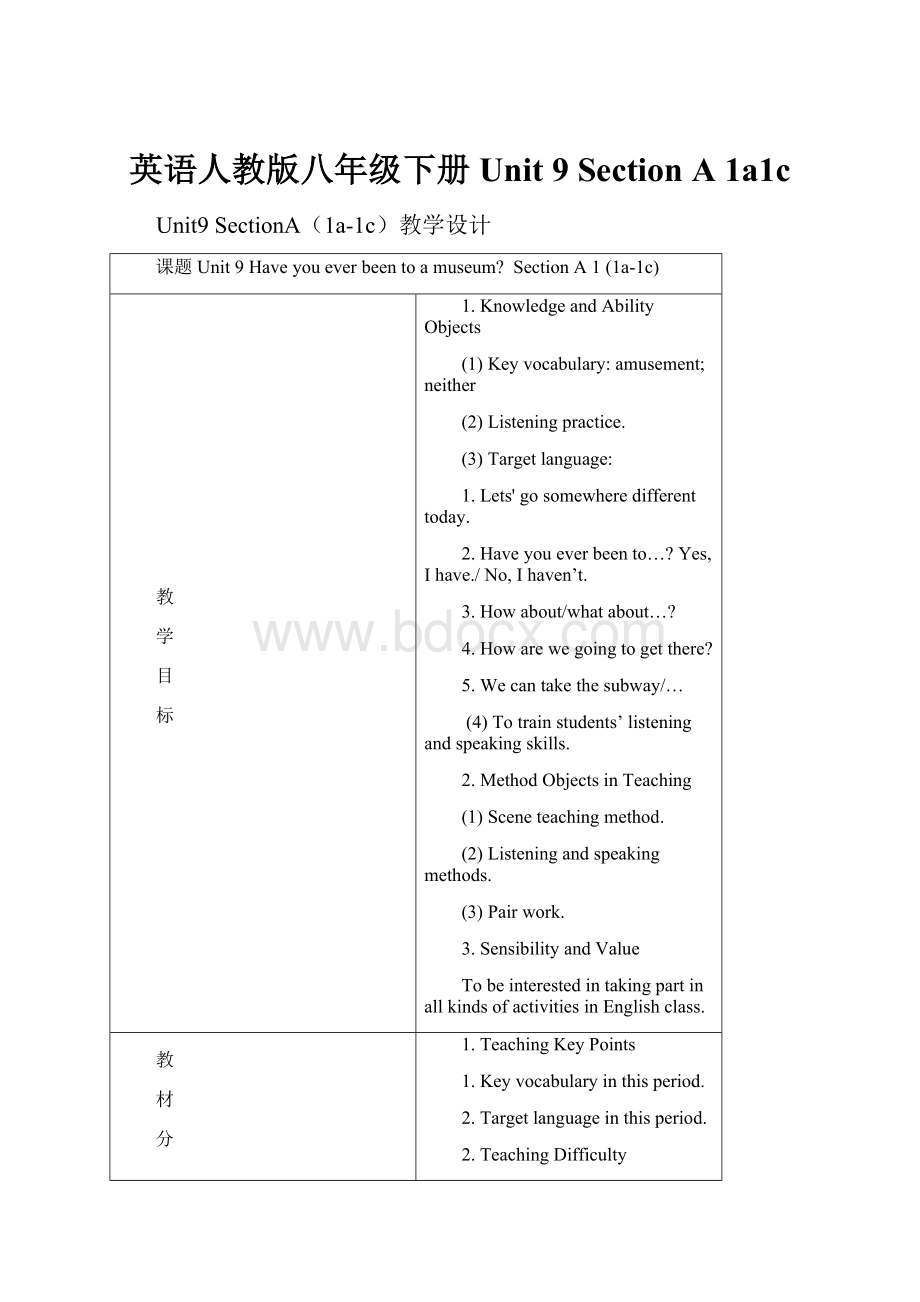英语人教版八年级下册Unit 9 Section A 1a1c.docx
《英语人教版八年级下册Unit 9 Section A 1a1c.docx》由会员分享,可在线阅读,更多相关《英语人教版八年级下册Unit 9 Section A 1a1c.docx(10页珍藏版)》请在冰豆网上搜索。

英语人教版八年级下册Unit9SectionA1a1c
Unit9SectionA(1a-1c)教学设计
课题Unit9Haveyoueverbeentoamuseum?
SectionA1(1a-1c)
教
学
目
标
1.KnowledgeandAbilityObjects
(1)Keyvocabulary:
amusement;neither
(2)Listeningpractice.
(3)Targetlanguage:
1.Lets'gosomewheredifferenttoday.
2.Haveyoueverbeento…?
Yes,Ihave./No,Ihaven’t.
3.Howabout/whatabout…?
4.Howarewegoingtogetthere?
5.Wecantakethesubway/…
(4)Totrainstudents’listeningandspeakingskills.
2.MethodObjectsinTeaching
(1)Sceneteachingmethod.
(2)Listeningandspeakingmethods.
(3)Pairwork.
3.SensibilityandValue
TobeinterestedintakingpartinallkindsofactivitiesinEnglishclass.
教
材
分
析
1.TeachingKeyPoints
1.Keyvocabularyinthisperiod.
2.Targetlanguageinthisperiod.
2.TeachingDifficulty
Makeconversationsfreelyusingthetargetlanguage.
3.TeachingAids
1.Ataperecorder.
2.Acomputerformultimediause.
时序
TeachingProcedures
Step1GreetingsandLead-in
1.Guesstheplacesofthepictures;theyaretheBritishMuseum,spacemuseum,historymuseum,waterpark,zoo,amusementparkwhileleadinsentencepatterns:
“Haveyoueverbeento…?
”
2.Speaking
Getstudentstoworkinpairstopracticetheconversation:
“Haveyoueverbeento…”
“Yes,Ihave”/Not,Ihaven’t.
Step3Pre-listening
1.SectionA1a
T:
OK.NowopenyourbooksonPage65.InPart1a,6placesaregiven.Pleasereadthenamesoftheseplaces.(Teacherwritesthenamesontheblackboard.)Whichoftheseplaceswouldyouliketovisit?
Rankthemfrom1to5.
S4:
Amusementpark______,waterpark______,zoo______aquarium______spacemuseum______.
S5:
Spacemuseum______,aquarium______,zoo______,waterpark______,amusementpark______
S6:
…
2.Talkaboutthepicture
Step4Listening
1.Listenandchoosethebestanswer.Thefirstandthesecondquestionaimtolisteningtotime,andthethirdoneaimstolistenfortherelationship.Thisactivitytrainsstudents’listeningabilityforlisteningforspecificrelationship.
1)WhendidSarahvisittheNationalScienceMuseum?
A.TodayB.YesterdayC.Lastyear
2)WhendidClaudiavisitthenaturemuseum?
A.lastyearB.lastsummerC.Lastschooltrip
3)Whatmaytherelationshipbebetweenthetwospeakers?
A.FriendsB.Teacherandstudent
C.Motherandkid.
Answer:
CCA
2.Listenagain.Listenandchecktheboxes.Havethesestudentseverbeentotheseplaces?
Sciencemuseum
Historymuseum
Artmuseum
Naturemuseum
Spacemuseum
Claudia
Sarah
√
Step5Speaking
Askandanswerinpairs:
A:
let’sgosomewheredifferenttoday.
B:
OK.Wheredoyouwanttogo?
A:
Haveyoueverbeentothespacemuseum?
B:
No,Ihaven’t.Howaboutyou?
A:
…
Step6Languagepoints
1.【易错易混点拨】:
havegoneto、havebeento和havebeenin的区别
一、havegoneto意为“到某地去”,说话时该人不在现场,一般不用第一人称、第二人称代词作句子的主语。
如:
—WhereisJim?
吉姆在哪里?
—HehasgonetoEngland.他去英国了。
(尚未回来)
Mr.Wangisn’there.HehasgonetoQingdao.王先生不在这里。
他去青岛了。
二、havebeento意为“曾经去过某地”,现在已不在那里了,后可接次数,如once,twice,threetimes等,表示“去过某地几次”,也可和just,never,ever等连用。
如:
MyfatherhasbeentoBeijingtwice.我父亲去过北京两次。
IhaveneverbeentotheGreatWall.我从未去过长城。
三、havebeenin表示“在某地待了多少时间”,常与时间段状语连用。
如:
IhavebeeninShanghaiforthreeyears.我到上海已有三年了。
HehasbeeninLondonforhalfamonth.他来伦敦已有半个月了。
Exercise
1.我去过北京两次。
I_________________Beijingtwice.
选用have,has填空:
1.I_______toldhimthenews.
2.She________comebackfromschool.
3.You________wonthegame.
1.Practicethedialogueandrememberthelanguagepoints.
2.Previewthenextlesson.
Step9BlackboardDesign
Lets'gosomewheredifferenttoday.
Haveyoueverbeento…?
Yes,Ihave./No,Ihaven’t.
Howabout/whatabout…?
Howarewegoingtogetthere?
Wecantakethesubway/…
词汇拓展:
中国的名胜古迹
十三陵TheMingTombs
雍和宫YongheLamasery
中华世纪坦ChinaCenturyAltar
秦始皇陵TheEmperorQinShihuang'sTomb
天安门广场Tian'anmenSquare
华表OrnamentalPillars
人民英雄纪念碑TheMonumenttothePeople'sHeroes
毛主席纪念堂ChairmanMaoMemorialHall
人民大会堂TheGreatHallofthePeople
故宫TheForbiddenCity
乾清宫ThePalaceofHeavenlyPurity
坤宁宫ThePalaceofEarthlyTranquility
御花园TheImperialGarden
九龙壁TheNineDragonScreen
天坛TheTempleofHeaven
回音壁EchoWall
祈年殿TheHallofPrayerforGoodHarvest
颐和园TheSummerPalace
佛香阁TheTowerofBuddhistIncense
石舫TheMarbleBoat
十七孔桥The17-ArchBridge
铜牛BronzeOx
谐趣园TheGardenofHarmoniousInterests
长城TheGreatWall
居庸关JuyongguanPass
北海公园:
BeihaiPark
故宫博物院:
thePalaceMuseum
革命历史博物馆:
TheMuseumofRevolutionaryHistory
天安门广场:
Tian’anmenSquare
毛主席纪念堂:
ChairmanMaoZedongMemorialHall
保和殿:
theHallofPreservingHarmony
中和殿:
theHallofCentralHarmony
长城:
theGreatWall
午门:
theMeridianGate
紫金山天文台:
PurpleandGoldHillsObservation
紫禁城:
theForbiddenCity
御花园:
ImperialGarden
颐花园:
SummerPalace
天坛:
TempleofHeaven
周口店遗址:
ZhoukoudianAncientSite
太和殿:
theHallofSupremeHarmony
祈年殿:
theHallofPrayerforGoodHarvest.
少年宫:
theChildren’sPalace
烽火台:
theBeaconTower
人民大会堂:
theGreatHallofthePeople
清东陵:
EastenRoyalTomsoftheQingDynasty
乾清宫:
PalaceofHeavenlyPurity
民族文化宫:
theCulturalPalaceforNationalities
劳动人民文化宫:
WorkerPeople’sCulturalPalace
北京工人体育馆:
BeijingWorkers’Stadium
护城河:
theMoat
仙人洞:
FairyCave
黄果树瀑布:
HuangguoshuFalls
西山晴雪:
theSunnyWesternHillsafterSnow
避暑山庄:
theImperialMountainSummerResort
龙门石窟:
LongmenCave
苏州园林:
SuzhouGardens
庐山:
LushanMountain
天池:
HeavenPoll
蓬莱水城:
PenglaiWaterCity
大雁塔:
BigWildGoosePagoda
华山:
HuashanMountain
峨眉山:
EmeiMountain
石林:
StoneForest
西湖:
WestLake
白马寺:
WhiteHorseTemple
白云山:
WhiteCloudMountain.
布达拉宫:
PotalaPalace
大运河:
GrandCanal
滇池:
DianchiLake
杜甫草堂:
DuFuCottage
都江堰:
DujiangDam
鼓浪屿:
GulangyuIslet
观音阁:
GoddessofMercyPavilion
归元寺:
GuiyuanBuddhistTemple
甘露寺:
SweetDewTemple
黄花岗七十二烈士墓:
Mausoleumofthe72Martyrs
华清池:
HuaqingHotSpring
昭君墓:
Zhaojun’sTomb
毛泽东故居:
MaoZedong’sFormerResidence
周恩来故居:
ZhouEnlai’sFormerResidence
越秀公园:
YuexiuPark
岳阳楼:
YueyangTower
南湖公园:
SouthLakePark
中山公园:
ZhongshanPark
漓江:
LijiangRiver
寒山寺:
HanshanTemple
静心斋:
Heart-EastStudy
黄鹤楼:
YellowCraneTower
黄山:
HuangshanMountain
天下第一关:
theFirstPassUnderHeaven
桂林山水:
GuilinScenerywithHillsandWaters
秦始皇兵马俑:
QinTerra-CottaWarriorsandHorsesFigurines
HuaQINGhotspring华清池
drumtower鼓楼
GreatGOOSEpagoda大雁塔
theWestLake西湖
泰山:
MountTaishan
庐山:
Mt.Lu天安门及广场Tian'anmenandTian'anmenSquare
故宫ThePalaceMuseum
天坛TheTempleofHeaven
颐和园TheSummerPalace
长城TheGreatWall
(八达岭长城TheGreatWallatBadaling
居庸关长城TheGreatWallatJuyongguanPass
慕田峪长城TheGreatWallatMutianyu
司马台长城TheGreatWallatSimatai)
明十三陵TheMingTombs
北海公园BeihaiPark
雍和宫YonghegongLarmasery
白云观TheWhiteCloudTaoistTemple
北京孔庙BeijingConfuciusTemple
国子监TheImperialCollege
潭柘寺TanzheTemple
圆明园TheRuinsofYuanmingyuan
周口店北京猿人遗址PekingManSiteatZhoukoudian
中华民族园ChineseEthnicCulturePark
世界公园BeijingWorldPark
中华世纪坛ChinaCenturyAltar
桂林山水theLandscapeofGuilin
杭州西湖theWestLakeofHangzhou
故宫theImperialPalace
苏州园林theGardensofSuzhou
安徽黄山MountHuangofAnhui
长江三峡theThreeGorgesontheYangtzeRiver
台湾日月潭theSunandMoonLakeofTaiwan
河北承德避暑山庄theSummerMountainResortinChengde,Hebei
陕西秦始皇陵兵马俑TerraCottaWarriors
半坡遗址BanPoVilligeRemains1
易错易混辨析:
现在完成时与一般过去时的区别
现在完成时与一般过去时的区别:
现在完成时用来表示之前已发生或完成的动作或状态,其结果的确和现在有联系。
动作或状态发生在过去,但它的影响现在还存在;而一般过去时表示过去的事实,不表示和现在的关系。
IhavejustbeentoLondon.Iwenttherelastmonth.我刚去过伦敦,是上个月去的。
1.过去时表示过去某时发生的动作或单纯叙述过去的事情,强调动作;现在完成时为过去发生的,强调过去的事情对现在的影响,强调的是影响。
2.过去时常与具体的时间状语连用,而现在完成时通常与模糊的时间状语连用,或无时间状语。
一般过去时的时间状语:
yesterday,lastweek,…ago,in1980,inOctober,justnow等具体的时间状语
现在完成时的时间状语:
for,since,sofar,ever,never,just,yet,till/until,uptonow,inpastyears,always等。
共同的时间状语:
thismorning,tonight,thisApril,now,once,before,already,recently,lately等。
3.现在完成时可表示持续到现在的动作或状态,动词一般是延续性的,如live,teach,learn,work,study,know。
过去时常用的非持续性动词有come,go,leave,start,die,finish,become,getmarried等。
举例:
Isawthisfilmyesterday. (强调看的动作发生过了。
)
Ihaveseenthisfilm. (强调对现在的影响,电影的内容已经知道了。
)
Whydidyougetupsoearly?
(强调起床的动作已发生过了。
)
Whohasn’thandedinhispaper?
(强调有卷子,可能为不公平竞争。
)
ShehasreturnedfromParis. 她已从巴黎回来了。
Shereturnedyesterday. 她是昨天回来了。
HehasbeenintheLeagueforthreeyears. (在团内的状态可延续)
HehasbeenaLeaguememberforthreeyears. (是团员的状态可持续)
HejoinedtheLeaguethreeyearsago. (三年前入团,joined为短暂行为。
)
Ihavefinishedmyhomeworknow.
—WillsomebodygoandgetDr.White?
—He’salreadybeensentfor.
4.句子中如有过去时的时间副词(如yesterday,last,week,in1960)时,不能使用现在完成时,要用过去时。
(错)Tomhaswrittenalettertohisparentslastnight.
(对)Tomwrotealettertohisparentslastnight.
【易错易混点拨】:
havegoneto、havebeento和havebeenin的区别
一、havegoneto意为“到某地去”,说话时该人不在现场,一般不用第一人称、第二人称代词作句子的主语。
如:
—WhereisJim?
吉姆在哪里?
—HehasgonetoEngland.他去英国了。
(尚未回来)
Mr.Wangisn’there.HehasgonetoQingdao.王先生不在这里。
他去青岛了。
二、havebeento意为“曾经去过某地”,现在已不在那里了,后可接次数,如once,twice,threetimes等,表示“去过某地几次”,也可和just,never,ever等连用。
如:
MyfatherhasbeentoBeijingtwice.我父亲去过北京两次。
IhaveneverbeentotheGreatWall.我从未去过长城。
三、havebeenin表示“在某地待了多少时间”,常与时间段状语连用。
如:
IhavebeeninShanghaiforthreeyears.我到上海已有三年了。
HehasbeeninLondonforhalfamonth.他来伦敦已有半个月了。